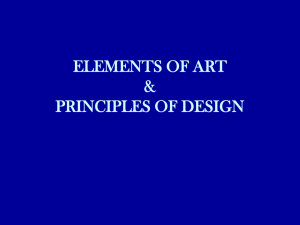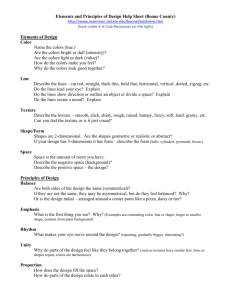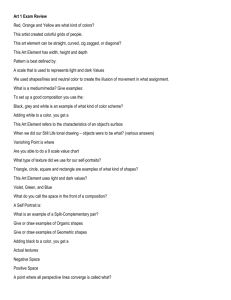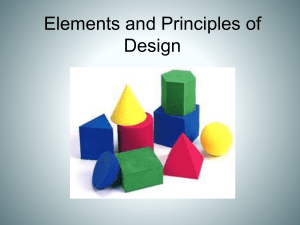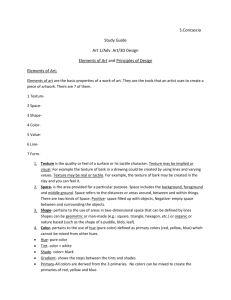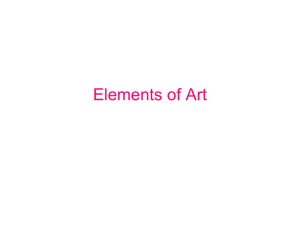Elements of Art
advertisement
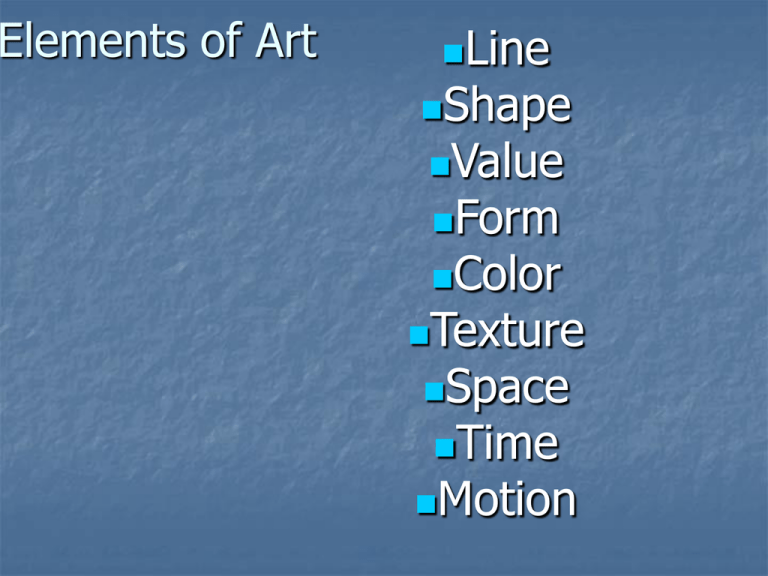
Elements of Art Line Shape Value Form Color Texture Space Time Motion Line Line is at once the simplest and most complex of the elements. Line is one dimensional. It is measured mainly by length. If a line becomes wide enough to measure width, it becomes a shape. “Composition with Red, Blue And Yellow”, Piet Mondrian, Oil on canvas, 1930 http://images.google.com/imgres?imgurl=http:// Expressive Qualities of Line The expressive characteristics of a line may be perceived as delicate, tentative, assertive, elegant, forceful and even brutal. “Lavender Mist Number 1”, 1950 Jackson Pollock, Oil On Canvas http://www.ibiblio.org/wm/paint/auth/pollock/lavender-mist/ Types of line Contour Linethese lines describe the outline shape of an object. It is the edge between the positive and negative space Actual line- This is a non-interrupted line. The points that make up this line are connected Implied Line- This could be a dotted or dashed line that your eye completes. - - - - - …………………………….. http://www.public.iastate.edu/~kjansen/art130.htm Functions of Line To outline a shape (this helps simplify shape for the viewer) To create depth and texture. Vincent Van Gogh uses line to describe. “Starry Night”, 1889, Vincent van Gogh Oil on Canvas http://www.harley.com/art/abstract-art/vangogh.html Functions of Line To suggest direction and movementhorizontal lines tend to communicate stability and calm, vertical lines suggest strength and authority (architecture), and diagonal lines tend to represent movement. “Harriet Tubman Series, No. 4”, 1939-40 Jacob Lawrence, Casein tempera on gessoed hard board http://www.phillipscollection.org/lawrence/tubmanpanel4.html Shape Two types of shapes- organic (biomorphic) and geometric Biomorphic shapes are natural- leaves, rivers, stones, mountains, sponges, animals Geometric shapes are manmade, they are regular and predictable. Squares, trapezoid Some shapes are amorphous- not easily defined as organic or geometric Shapes are two-dimensional. They are measured by length and width Form Forms refer to three-dimensional shapes. Forms are measured by length, width and depth. This sculpture by David Smith is a good example of geometric forms. The Guggenheim Museum in Bilbao, XVIII”, David Smith, polished stainless steel, Spain, 1997 is an “Cubi 1964 organic form. http://faculty.evansville.edu/rl29/art105/img/smith_ cubixviii.jpg Shape, Form, Space Volume is the related amount of space a form uses. Positive and negative space refer to the areas where objects are and where there is only air. Positive indicated filled space, Negative indicates empty space. Together these two form Figure-ground relationships Figure-ground reversals create optical illusions that contradict our perceptions of positive and negative. Mass- the mass of an object refers to its bulk. A solid work made out of steel the same dimensions as a sculpture made out of cotton would have more mass. “Paysage” , 1961, Jean Arp http://surrealists.classifieds4u.co.uk/ viewPicture/13/ Squares with Two Circles (Monolith), Barbara Hepworth, 1963 (cast 1964). Brown with green patina. 124 x 65 x 30 in. http://www.dukemagazine.duke.edu/dukemag/issues/050603/collector2.html Light and Value Value- is the relative lightness or darkness of an art element. The value of a color is the lightness or darkness of that color’s surface. Value is determined by the amount of light reflected by the surface. Chiaroscuro- the gradual shifting from light to dark through a successive gradation of tones across a curved surface. By using many gradations, objects portrayed on a flat surface can be given a rounded, three-dimensional appearance. Chiaroscuro “The Sleeping Gypsy”, 1897, Henri Rousseau Oil onCanvas Old Woman with a Candle 1661, Gerrit Dou Oil on oak, 31 x 23 cm 89 Seconds at Alcazar, Eve Sussman, 2004, Single channel video, video still Eve Sussman's 89 Seconds at Alcázar, 2004, is a High-Definition video tableau inspired by Diego Velázquez’ famous painting Las Meninas, 1656, at the Museo del Prado. The video is an artistic revisioning of the moments leading up to and directly following the approximately eighty-nine seconds in time when the royal family and their courtiers would have come together in the exact configuration in Velázquez’ painting. Color Light broken down into wavelengths. The wavelength of light determines its hue. Hue=color The value of color is its degree of darkness or light. Yellow is the lightest color and violet is the darkest. Color saturation is the pureness of a color. Pure hues have the greatest intensity, or brightness. The saturation, or intensity, decrease when another hue, black , gray or white are added to it. Artists produce shades of a hue by adding black and tints of a hue by adding white. Complementary colors are opposite each other on the color wheel. Analogous colors are three (or more) colors in a row on the color wheel. “Folklore”, Victor Vasarely, print edition http://www.prints.co.nz/page/fine-art/PROD/Surrealism/1421 “The Night Café”, 1888, Vincent Van Gogh, oil on canvas http://www.cssh.qc.ca/ecoles/simon/museedesenfants.quebec/stsimon1/Students/Antoine/van_gogh/ Color Primary colors are red, yellow, and blue. They can not be produced by mixing two other colors together. Secondary colors are violet, orange and green. They are created by mixing two primary colors together. Local vs. Optical- Local color is the color that an object has in normal light Optical color is the color produced by our visual perception. “Haystack at Sunset Near Giverny”, Claude Monet is a great example of optical color. Mme Matisse: Madras Rouge (The Red Madras Headress) Summer 1907 (120 Kb); Oil on canvas, http://www.ibiblio.org/w m/paint/auth/matisse/ Texture Actual texture- is tactile, it is more than just visual information. Texture can be rough, smooth, or something in between. Think of the texture of glass versus a Triscuit cracker. Visual texture- is the illusion of texture in artwork. Trompe l’oeil (“fool the eye”) is a method of art that is intended to create a realistic illusion of texture and depth in a work of art. Subversive texture- contradicts our past visual experience by using texture in a way that is unexpected. “Object” by Meret Oppenheim is a good example of this. `”Object” by Meret Oppenheim, fur covered cup, saucer, and spoon, 1936 http://www.moma.org/ecards/write_ecard.php?object_id=80997 Space No subject exists in and of itself. When nearby objects are placed in front of more distant objects they obscure part or all of the distant objects. When objects overlap this gives us a sense of perspective. Perspective is a sense of depth (created as an illusion in art to give a sense of a three dimensional object on a two-dimensional picture plane) Linear perspective is a mathematical system for organizing space in a convincing way. Perspective http://faculty.evansville.edu/rl29/h340/f05/renaissancepainting.html Time and Motion Actual motion is live movement. A work of kinetic art like Alexander Calder’s mobiles actually moves when we see it in person. Implied Motion and Time- is a non-moving image that shows movement through the attributes present in the image. Good examples of this are found in Bernini’s “Apollo and Daphne” The Illusion of Motion is what we experience when we see a movie or series of shapes that note a passage of time. A movie is a series of still frames that do not contain actual motion, but when shown in a time sequence, create an illusion of motion. Giacomo Balla, Dynamism of a Dog on a Leash, 1912. Oil on Canvas Calder’s Mobiles http://students.washington.edu/brandond/Page0004.html

